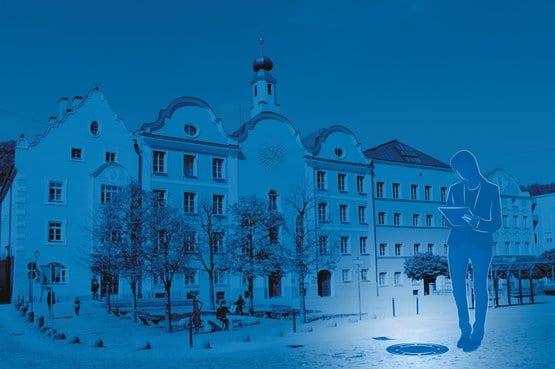Good news from the future

Sewers and sewage treatment plants adapt to the wastewater volumes
May 2035: Emma Lehmkuhl has all reasons to be happy. The city treasurer has just learned that their municipality is debt-free. At the beginning of the millennium, the 460,000-inhabitant city was still in the red. However, their predecessors in the administration decided correctly at the time when they relied on smart-controlled sewer management to refurbish the sewage network.
Even then, demographic change was apparent: large cities are growing small towns and communities are shrinking. The wastewater volumes change accordingly. Fortunately, Ms. Lehmkuhl's municipality was able to control these quantities flexibly and just in time. Also, because they were always informed about the amount of water in the sewer system and about the condition of the lines and systems using sensors and networked IT from HST.
This allowed the resources in sewage treatment plants and sewer networks to be optimally utilized. Costly overcapacity or bottlenecks were avoided due to the smart control. All of that saved real money.

Medicines can be filtered without residue
February 2032: The first official Sun Valley on the American model is opened in southern Germany, the demographic change leaves its mark. In the US, the so-called Old Towns have long been popular. Space is limited, the waiting lines are long. Everything in these cities is designed to meet the needs of the 1970s generation: low curbs, large-sized signs, flat entrances to shops, etc.
When planning the city in Bavaria, everything that was not immediately visible was also tuned accordingly. Eventually, the planners, for example at the sewage treatment plant, assumed that the town's sewage would have an above-average concentration of drug residues. Older people often take up to eight different medicines per day. In addition, according to the calculation, the volume of water in the city is correspondingly high, as older people are less mobile and more likely to stay in their own areas. And if, during the holiday season, many should stay with their families outside the city, this must be taken into account and processed through the control of the sewage system. Corresponding operating systems have since been helping municipal operators to control the sewer system and sewage treatment plants in a smart way.

Sewer network data is available everywhere
July 2018: Manuela Ziegler stands on a manhole cover, but she is surfing through the sewer system under her on her smart tablet device. She sees which channels, where they are located and how much volume of water are passing through. Virtually, of course. The employee of the municipal wastewater treatment plant has to check a sewer line and calls up all relevant data.
This task used to require a call to the head office, which is cumbersome to use vague location descriptions to roughly tell where the channel was going. Now Ziegler can see the sewer system from anywhere in the 40,000-inhabitant city. Almost four years ago, the municipality transferred all the information to a data cloud. Of course, there were concerns at the beginning, but a private data cloud is very suitable for this purpose and absolutely secure. Ultimately, the municipality wanted to focus again on its core tasks, namely the supply and disposal. The constantly growing technical requirements were too expensive for the small administration. The step into the cloud was close. Now all employees of the disposal plants are constantly online while they are working and can always call up current geo-positions and factual and operational data. Work processes are optimized and work resources used more efficiently.

"Drowning in data" becomes manageable
October 2021, a big city in Germany: Martin Tröger looks in the municipal sewage control center on two curves. There are only two today, which are unusual. Everything else works flawlessly. Tröger knows this from his HST-SCADA system, which is independently analyzed and fed by many small helpers: strategic measuring points on the buildings in the sewer network, which deliver their data to the HST SCADA system. In the past, Tröger had to look at all the data curves for the 70 structures, including rainwater basins and pumping stations, on a daily basis and check for unusual events. Even those who practiced like him needed at least two hours to review all of the nearly 500 bends.
However, in 2013, the number of measurement parameters continued to increase. Big Data! More and more qualitative measurements, e.g. on wastewater quality were added, the environmental regulations were more complex, EU regulations required an expansion of the volume measurements. Tröger's colleagues from the waterworks, where the total data volume consists of more than 15,000 data points, have also opted for HST-SCADA. Enormous time is saved and work becomes easier. HST-SCADA: the "machete" in the data forest.





